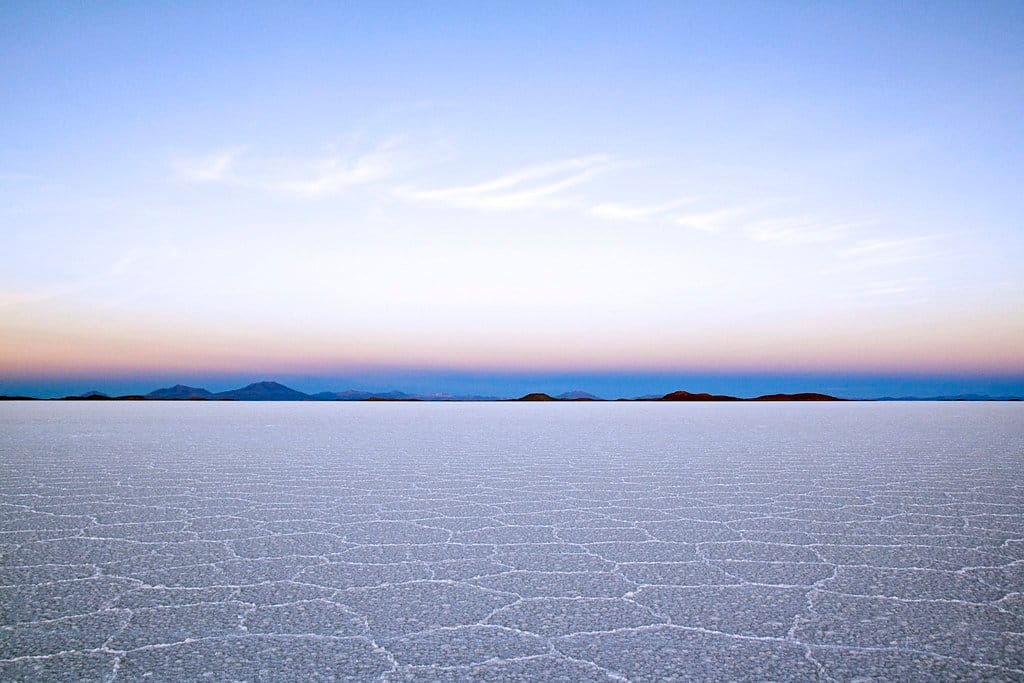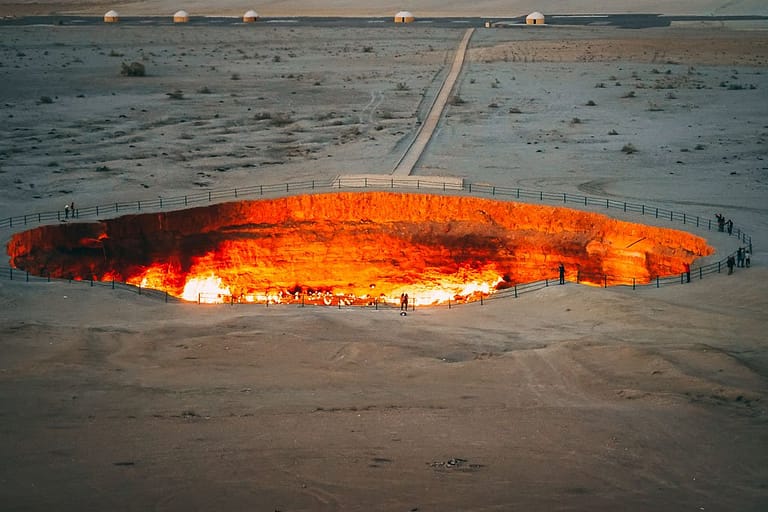Embarking on a journey to explore lesser-known landmarks offers a unique opportunity to discover the hidden gems of our world. These 15 remarkable destinations, ranging from surreal natural wonders to ancient architectural marvels, showcase the diversity and beauty of our planet. Each site holds a story that transcends time, offering a glimpse into the past, the resilience of nature, and the ingenuity of human civilizations.
Salar de Uyuni, Bolivia

The Salar de Uyuni, nestled in the Andes in southwest Bolivia, is the world’s largest salt flat, spanning a vast 10,582 square kilometers. Formed as a result of transformations between several prehistoric lakes, it’s so extraordinarily flat that it’s used to calibrate the altimeters of Earth observation satellites. During the rainy season, it becomes a giant mirror, perfectly reflecting the sky and creating a surreal landscape that’s a photographer’s paradise. This remarkable site also contains 50 to 70% of the world’s lithium reserves, crucial for batteries in electronics and electric vehicles. Besides its economic importance, the Salar is a breeding ground for several species of flamingos and a crucial part of their migratory patterns.
Derweze Gas Crater, Turkmenistan

Located in the heart of the Karakum Desert in Turkmenistan, the Derweze Gas Crater, often referred to as the “Door to Hell,” is a fiery testament to the power of natural gas. The crater, measuring about 70 meters in diameter, was created in 1971 when a Soviet drilling rig accidentally punctured an underground cavern, causing the ground to collapse and the entire drilling rig to fall in. To prevent the spread of methane gas, geologists decided to set it on fire, expecting it to burn out in a few weeks. However, the crater has been burning continuously for over 50 years, becoming one of the most bizarre and unique attractions in the world. Its eerie glow can be seen from miles away, especially at night, making it a surreal and somewhat intimidating spectacle.
Rock-Hewn Churches of Lalibela, Ethiopia

In the town of Lalibela in northern Ethiopia, a remarkable architectural feat takes the form of 11 medieval churches, each carved downwards out of solid volcanic rock. Dating back to the 12th and 13th centuries, these churches are attributed to King Lalibela, who aimed to create a ‘New Jerusalem’ for those unable to make the pilgrimage to the Holy Land. Each church is uniquely designed, some connected by tunnels and trenches, others standing entirely free. The most famous, Bet Giyorgis, is carved in a cross shape and is particularly well-preserved. These churches continue to be a place of pilgrimage and devotion for Ethiopian Orthodox Christians, a living testament to the country’s long and unique Christian tradition.
Lake Baikal, Russia

Lake Baikal, located in Siberia, Russia, is a natural wonder of extraordinary proportions. It’s the deepest (1,642 meters) and oldest (25 million years) freshwater lake in the world, containing more than 20% of the world’s unfrozen freshwater reserve. Known as the ‘Galapagos of Russia,’ its age and isolation have created one of the most biodiverse ecosystems on earth, including many species found nowhere else, like the Baikal seal. In winter, the lake transforms into a frozen landscape with transparent ice that can support vehicles, creating a mesmerizing, otherworldly scene. The indigenous Buryat tribes, who live on the eastern side of the lake, practice shamanism and have a deep spiritual connection to this unique natural wonder.
Rapa Nui (Easter Island), Chile

Rapa Nui, also known as Easter Island, is one of the most isolated inhabited islands in the world, located in the southeastern Pacific Ocean. It is famous for its 887 enigmatic monumental statues, called moai, created by the early Rapa Nui people between the 13th and 16th centuries. These towering stone figures, averaging 4 meters in height and weighing about 14 tons each, are believed to represent the spirits of ancestors and high-ranking individuals. The moai are mostly found along the island’s coastline, gazing inland across their clan lands, with the exception of seven that look out to sea to help travelers find the island. The construction and transportation of these massive statues remain a subject of archaeological debate. The isolated and mysterious nature of Easter Island, combined with the intriguing and impressive moai, make it a fascinating destination for archaeologists and travelers alike.
Pamukkale, Turkey

Pamukkale, meaning “Cotton Castle” in Turkish, is a stunning natural wonder in southwestern Turkey known for its white terraces and warm, mineral-rich waters. These terraces are made of travertine, a sedimentary rock deposited by water from the hot springs, and have been used as a thermal bath since ancient times. The site, alongside the ancient city of Hierapolis built just above the terraces, is a UNESCO World Heritage Site. Visitors can walk in the warm waters that flow over the terraces, which are said to have healing properties. The contrast of the dazzling white terraces against the blue sky creates an almost otherworldly landscape, attracting thousands of tourists every year.
Tsingy de Bemaraha, Madagascar

Tsingy de Bemaraha, located in western Madagascar, is a unique and dramatic landscape known for its ‘forest’ of limestone needles. This UNESCO World Heritage Site is characterized by its jagged, razor-sharp pinnacles formed through erosion of the limestone over millions of years. The word ‘Tsingy’ translates to ‘where one cannot walk barefoot’ in the Malagasy language, aptly describing its treacherous terrain. This labyrinth of limestone offers a unique habitat for various species of flora and fauna, including several types of lemurs and birds that are endemic to Madagascar. The park also features impressive canyons, rolling hills, and forests, making it a haven for adventurous hikers and nature lovers.
The Giant’s Causeway, Northern Ireland

The Giant’s Causeway, located on the northeast coast of Northern Ireland, is an area of about 40,000 interlocking basalt columns, the result of an ancient volcanic eruption. Legend has it that the columns are the remains of a causeway built by a giant, but in reality, they were formed around 60 million years ago by rapidly cooling lava. The columns, mostly hexagonal, form a pathway that leads from the cliff foot and disappears under the sea. It’s Northern Ireland’s only UNESCO World Heritage Site and is one of the most popular tourist attractions in the region. The uniqueness and beauty of the basalt columns, combined with the myths and legends surrounding them, make the Giant’s Causeway a must-visit destination.
The Catacombs of Paris, France


The Catacombs of Paris are a vast network of underground ossuaries in the heart of Paris, which hold the remains of more than six million people. Created in the late 18th century, the catacombs were established to tackle the city’s overflowing cemeteries. The bones were transferred into the abandoned quarry tunnels under Paris, and over time, these bones were arranged into the macabre displays seen today. This underground labyrinth, with its dark and eerie tunnels lined with skulls and bones, offers a haunting yet fascinating glimpse into Paris’s history. The catacombs are a testament to the city’s past and present, and a visit there is a journey into the depths of Parisian history.
Meteora Monasteries, Greece

The Meteora Monasteries in Greece are a striking set of Eastern Orthodox monasteries perched atop massive rock pillars formed over 60 million years ago. Located in the Thessaly region, the name ‘Meteora’ means ‘suspended in the air’, which aptly describes these structures. Of the original 24 monasteries, only six remain today and are accessible by staircases cut into the rock formations. These monasteries were built during the 14th and 16th centuries by monks seeking spiritual isolation and freedom from religious persecution. The combination of natural beauty and architectural marvel makes Meteora one of the most spectacular and unique monastic communities in the world. Its blend of natural and man-made wonders has earned it a UNESCO World Heritage Site designation.
Cappadocia Underground Cities, Turkey


The underground cities of Cappadocia, central Turkey, are a remarkable network of tunnels and rooms carved deep into the volcanic rock. The most famous, Derinkuyu and Kaymakli, date back to at least the 8th–7th centuries B.C. Originally used by the Phrygians, these cities were expanded by early Christians as hiding places during times of persecution. These subterranean complexes could accommodate thousands, complete with ventilation shafts, chapels, storerooms, and even wine presses. The largest, Derinkuyu, goes down to a depth of approximately 85 meters and could house as many as 20,000 people along with their livestock. These cities are a testament to human ingenuity and the will to survive under difficult circumstances. Today, they offer a fascinating glimpse into ancient life and are a highlight for visitors to Cappadocia.
The Wave, Arizona, USA

The Wave, located in the Coyote Buttes area on the Arizona-Utah border, is an awe-inspiring sandstone rock formation known for its undulating forms and vibrant coloration. The swirling patterns in the rock, formed from Jurassic-age sand dunes compacting and then eroding, create a surreal and dreamlike landscape. Due to its fragile nature, access to The Wave is limited to 20 permits per day, awarded by lottery, making it a coveted destination for hikers and photographers. The challenging hike to reach The Wave traverses a rugged, trackless landscape, but the reward is a view of one of the most picturesque and unique geological formations in the world.
Mount Roraima, Venezuela/Brazil/Guyana

Mount Roraima is a stunning tabletop mountain (tepui) that serves as the tripoint of Venezuela, Brazil, and Guyana. It’s one of the oldest geological formations on Earth, dating back two billion years. The mountain’s flat top is covered with unique flora and fauna, some of which are found nowhere else. The 400-meter-high cliffs surrounding the plateau give it an isolated and mystical feel, often shrouded in clouds. Indigenous peoples consider it a sacred place, and it’s said to have inspired Sir Arthur Conan Doyle’s novel “The Lost World.” Trekking to the top is a challenging but rewarding experience, offering breathtaking views and a chance to explore a truly unique ecosystem.
Wulingyuan Scenic Area, China

Wulingyuan Scenic Area in Hunan Province, China, is renowned for its over 3,000 sandstone pillars, many over 200 meters in height, amid ravines and gorges with streams, pools, and waterfalls. This UNESCO World Heritage Site, famous for inspiring the floating mountains in the movie “Avatar,” offers a stunning panorama of towering peaks and lush vegetation. The pillars formed through physical erosion over hundreds of thousands of years. The area is also home to several endangered plant and animal species. The scenic area includes several national parks, the most famous being Zhangjiajie National Forest Park, where visitors can explore the natural beauty via extensive walking paths, cable cars, and the world’s longest and highest glass bridge.
Socotra Island, Yemen

Socotra Island, off the coast of Yemen, is often described as the most alien-looking place on Earth due to its unique and bizarre flora. Its isolation has resulted in a high degree of endemism, with about a third of its plant life found nowhere else. The most iconic is the Dragon’s Blood Tree, with an umbrella-shaped canopy and red sap. The island’s landscape is a mix of sandy beaches, limestone plateaus full of caves, and mountains. Socotra is a UNESCO World Heritage Site due to its biodiversity and has been called the “Galapagos of the Indian Ocean.” The mix of unique wildlife, surreal landscapes, and relative isolation makes Socotra a fascinating destination for nature enthusiasts and adventurers.

